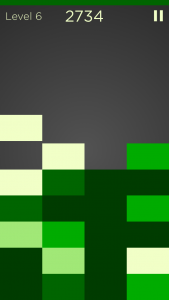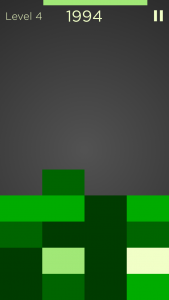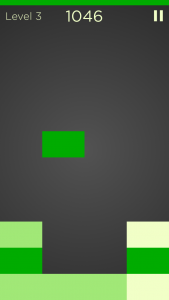No, it’s not a game about kilts. It’s even better.
Shades is a minimalist puzzle game that takes Tetris, slims it down, adds a beautiful, calming soundtrack and an easy-to-understand interface, then takes it all into another dimension by using shades of color, not just matching colors, as its main mechanic. The result has been described as a Zen-like, a game that starts out peaceful and quickly turns into a mad dash. All of this has landed Shades on Apple’s “App of the Week” and “Best New Games” list.
So, Shades starts out simple: little blocks of color start falling down the screen. You can swipe to move them left or right, or down to make them move faster. When two blocks of the same color are stacked on top of one another, they combine to form a darker color, and when you create a row of blocks with the same color, it disappears. You gain points for merging blocks of the same color, and a lot more points for clearing a row. Sounds easy enough.
Well, that’s where you’d be wrong. If you play Shades right, your whole landscape of blocks should be constantly changing: merging blocks to get them darker, creating columns of similar colors to use as sinks, watching rows change color, and all of it building toward those massive point combos. These mechanics make it devilishly difficult to keep a handle on the stream of incoming blocks, and things only get more difficult once you start seeing four or five different shades. You’ll be surprised how hard it is to train yourself to spot a lime-green apart from an olive-green.
Read further for our Shades tips!
1. Get Your Rows Dark
First, try to get your rows as dark as possible in order make sure that they all match–it’s hard to keep lighter rows light, since they’ll often be required to soak up new blocks. When you’ve learned how to manage the colors of your blocks, try and get them all as dark as you can, then arrange the new blocks so they start to get absorbed by your rows. This is one of the most basic tips for Shades, but it’s one of the most effective.
2. Don’t Stack Dark on Light
Second, don’t let darker blocks stack on top of lighter blocks–you won’t be able to clear either one efficiently. This is similar to stacking a long squiggly block on a square in Tetris–it just takes up space, and strands everything below it.
3. Soak Up Blocks and Plan for the Future!
Third, keep your eye on what blocks can be used to soak up others, and use them as banks for later on–start building around them! This mixes well with the first tip. Each block is a short-term payoff or a long-term payoff: either they get cleared quickly, or require more maneuvering. Think about which ones you need to invest in and build around, then get them as dark as you can.
These tips will help you conquer the tartan-colored world of Shades–good


